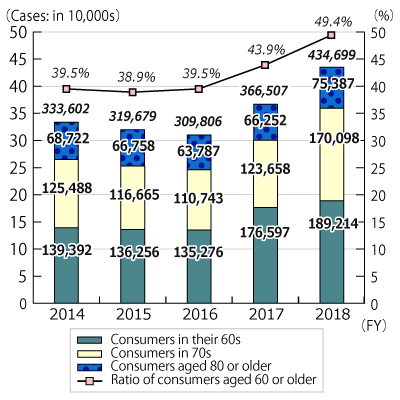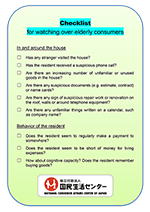Over 400,000 troubles experienced by consumers aged 60 or older! Learn from current problems to prevent them in the future
Local consumer affairs centers and the like across Japan have received an increasing number of inquiries about troubles experienced by consumers aged 60 or older. In FY2018, the annual number of the inquiries amounted to over 430,000 (49.4%), the highest in this decade (See Diagram).
Troubles experienced by consumers aged 60 or older are often related to billing fraud, information communications service such as digital contents and Internet connection, which are common in all the age groups over 60. Consumers in their 60s and 70s tend to experience more troubles related to communications service and mail-order service than older consumers. On the other hand, consumers aged 80 or older tend to experience more troubles related to door-to-door sales and telemarketing.
Troubles experienced by consumers aged 60 or older are roughly divided into two types: those often experienced by consumers in their 60s-70s and those often experienced by consumers aged 80 or older. Therefore, NCAC decided to issue an alert to consumers, describing the two types of trouble.
Diagram: Number of inquiries about troubles experienced by consumers aged 60 or older registered with PIO-NET* and the ratio thereof

The total number of inquiries received from FY2014 through FY2018 excluding unknown cases was 4,163,816. Of these, cases of consumers aged 60 or older amounted to 1,764,293.
In FY2014, cases of consumers aged 60 or older amounted to 333,602. Of these, cases of consumers in their 60s amounted to 139,392; cases of consumers in their 70s amounted to 125,488; and cases of consumers aged 80 or older amounted to 68,722. The ratio of cases of consumers aged 60 or older accounted for 39.5% of the annual total.
In FY2015, cases of consumers aged 60 or older amounted to 319,679. Of these, cases of consumers in their 60s amounted to 136,256; cases of consumers in their 70s amounted to 116,665; and cases of consumers aged 80 or older amounted to 66,758. The ratio of cases of consumers aged 60 or older accounted for 38.9% of the annual total.
In FY2016, cases of consumers aged 60 or older amounted to 309,806. Of these, cases of consumers in their 60s amounted to 135,276; cases of consumers in their 70s amounted to 110,743; and cases of consumers aged 80 or older amounted to 63,787. The ratio of cases of consumers aged 60 or older accounted for 39.5% of the annual total.
In FY2017, cases of consumers aged 60 or older amounted to 366,507. Of these, cases of consumers in their 60s amounted to 176,597; cases of consumers in their 70s amounted to 123,658; and cases of consumers in their 80s amounted to 66,252. The ratio of cases of consumers aged 60 or older accounted for 43.9% of the annual total.
In FY2018, cases of consumers aged 60 or older amounted to 434,699. Of these, cases of consumers in their 60s amounted to 189,214; cases of consumers in their 70s amounted to 170,098; and cases of consumers in their 80s amounted to 75,387. The ratio of cases of consumers aged 60 or older accounted for 49.4% of the annual total.
- * PIO-NET is a database that collects information on inquiries concerning consumer affairs by linking NCAC with local consumer affairs centers and similar organizations across Japan via an online network. PIO-NET does not include inquiries referred from local consumer affairs centers to NCAC. The graph shows data registered through July 31, 2019.
Sampling of inquiries and complaints
- [Case1]
- Postcard notifying lawsuit was delivered, and I contacted the lawyer written on the postcard. Then, I was billed for abandoning the case.
- [Case2]
- Being solicited by a seller pretending to be with a subsidiary of my contractor, I happened to conclude a contract for optical fiber communications service with an unknown company.
- [Case3]
- An unknown visitor solicited me to repair the roof and I concluded a contract for painting the roof. Later I applied for cancellation of the contract, but the company rejected my request.
- [Case4]
- I wanted to rent an apartment, but the apartment owner did not allow me to do so because of my age.
- [Case5]
- I signed up for smartphone and tablet communication service without understanding contract details. Later, I was charged hefty fees.
- [Case6]
- Being solicited by door-to-door sales persons, some elderly consumers having dementia happened to order renovation work or futons one after another. Now they are short of money for living expenses.
- [Case7]
- I received a phone call from a man claiming to be a fisherman in a devastated area. I happened to purchase fish and seafood from him.
Characteristics of troubles experienced by consumers aged 60 or older
- Many of the troubles are related to information communications service.
- The older the consumers become, the more likely they encounter trouble related to door-to-door sales and telemarketing.
Advice for consumers
- Any consumer might encounter trouble. Be prepared instead of thinking "It will never happen to me." Look to various kinds of trouble experienced by consumers on a daily basis.
- In order to prevent trouble, family and others nearby need to watch over elderly people.
- In case of concern or trouble, consult your local consumer affairs center.
Checklist for watching over elderly people
The following shows a useful checklist for watching over elderly consumers.
Checklist for watching over elderly consumers
In and around the house
- Has any stranger visited the house?
- Has the resident received a suspicious phone call?
- Are there an increasing number of unfamiliar or unused goods in the house?
- Are there any suspicious documents (e.g. estimate, contract) or name cards?
- Are there any sign of suspicious repair work or renovation on the roof, walls or around telephone equipment?
- Are there any unfamiliar things written on a calendar, such as company name?
Behavior of the resident
- Does the resident seem to regularly make a payment to somewhere?
- Does the resident seem to be short of money for living expenses?
- How about cognitive capacity? Does the resident remember buying goods?
Checklist

